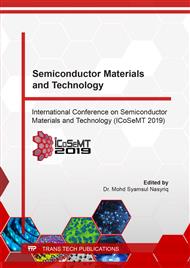[1]
S. M. R. Khalili and B. Saboori, Transient dynamic analysis of tapered FRP composite transmission poles using finite element method,, Compos. Struct., vol. 92, no. 2, p.275–283, (2010).
DOI: 10.1016/j.compstruct.2009.07.026
Google Scholar
[2]
F. X. Irisarri, A. Lasseigne, F. H. Leroy, and R. Le Riche, Optimal design of laminated composite structures with ply drops using stacking sequence tables,, Compos. Struct., vol. 107, p.559–569, (2014).
DOI: 10.1016/j.compstruct.2013.08.030
Google Scholar
[3]
V. Shubina, L. Gaillet, T. Chaussadent, T. Meylheuc, and J. Creus, Biomolecules as a sustainable protection against corrosion of reinforced carbon steel in concrete,, J. Clean. Prod., vol. 112, p.1–6, (2015).
DOI: 10.1016/j.jclepro.2015.07.124
Google Scholar
[4]
B. Saboori and S. M. R. Khalili, Static analysis of tapered FRP transmission poles using finite element method,, Finite Elem. Anal. Des., vol. 47, no. 3, p.247–255, (2011).
DOI: 10.1016/j.finel.2010.10.002
Google Scholar
[5]
A. Z. Fam and J.-K. Son, Finite element modeling of hollow and concrete-filled fiber composite tubes in flexure: Optimization of partial filling and a design method for poles,, Eng. Struct., vol. 30, no. 10, p.2667–2676, (2008).
DOI: 10.1016/j.engstruct.2008.02.015
Google Scholar
[6]
L. Caracoglia and A. Velazquez, Experimental comparison of the dynamic performance for steel, aluminum and glass-fiber-reinforced-polymer light poles,, Eng. Struct., vol. 30, no. 4, p.1113–1123, (2008).
DOI: 10.1016/j.engstruct.2007.07.024
Google Scholar
[7]
A. Kumar, S. Panda, S. Kumar, and D. Chakraborty, A design of laminated composite plates using graded orthotropic fiber-reinforced composite plies,, Compos. Part B Eng., vol. 79, p.476–493, (2015).
DOI: 10.1016/j.compositesb.2015.05.009
Google Scholar
[8]
R. M. Christensen, Failure Criteria for Anisotropic Fiber Composite Materials,, Fail. Theory Mater. Sci. Eng., (2008).
Google Scholar
[9]
G. Soremekun, Z. Gürdal, R. T. Haftka, and L. T. Watson, Composite laminate design optimization by genetic algorithm with generalized elitist selection,, Comput. Struct., vol. 79, no. 2, p.131–143, (2001).
DOI: 10.1016/s0045-7949(00)00125-5
Google Scholar
[10]
M. R. Ahmadian, A. Vincenti, and P. Vannucci, A general strategy for the optimal design of composite laminates by the polar-genetic method,, Mater. Des., vol. 32, no. 4, p.2317–2327, (2011).
DOI: 10.1016/j.matdes.2010.08.036
Google Scholar
[11]
C. Laval, M. Sa, and C. Star, Composites design in Designing with composites is a complex process . Christian Laval of MATERIAL SA,, no. September, p.50–53, (2003).
Google Scholar
[12]
H. Fadli, A. Marzuki, and M. Jaafar, Laminate Design of Lightweight Glass Fiber Reinforced Epoxy Composite for Electrical Transmission Structure,, Procedia Chem., vol. 19, p.871–878, (2016).
DOI: 10.1016/j.proche.2016.03.128
Google Scholar
[13]
M. Bodaghi, C. Cristóvão, R. Gomes, and N. C. Correia, Experimental characterization of voids in high fibre volume fraction composites processed by high injection pressure RTM,, Compos. Part A Appl. Sci. Manuf., vol. 82, p.88–99, (2016).
DOI: 10.1016/j.compositesa.2015.11.042
Google Scholar
[14]
N. Graupner, G. Ziegmann, F. Wilde, F. Beckmann, and J. Müssig, Procedural influences on compression and injection moulded cellulose fibre-reinforced polylactide (PLA) composites: Influence of fibre loading, fibre length, fibre orientation and voids,, Compos. Part A Appl. Sci. Manuf., vol. 81, p.158–171, (2016).
DOI: 10.1016/j.compositesa.2015.10.040
Google Scholar
[15]
L. Zhuang and R. Talreja, Effects of voids on postbuckling delamination growth in unidirectional composites,, Int. J. Solids Struct., vol. 51, no. 5, p.936–944, (2014).
DOI: 10.1016/j.ijsolstr.2013.11.021
Google Scholar
[16]
W. V. Liebig, C. Viets, K. Schulte, and B. Fiedler, Influence of voids on the compressive failure behaviour of fibrereinforced composites,, Compos. Sci. Technol., vol. 117, p.225–233, (2015).
DOI: 10.1016/j.compscitech.2015.06.020
Google Scholar
[17]
Z. Jing, X. Fan, and Q. Sun, Stacking sequence optimization of composite laminates for maximum buckling load using permutation search algorithm,, Compos. Struct., vol. 121, p.225–236, (2015).
DOI: 10.1016/j.compstruct.2014.10.031
Google Scholar
[18]
U. A. Khashaba, T. A. Sebaey, and K. A. Alnefaie, Failure and reliability analysis of pinned-joints composite laminates: Effects of stacking sequences,, Compos. Part B Eng., vol. 45, no. 1, p.1694–1703, (2013).
DOI: 10.1016/j.compositesb.2012.09.066
Google Scholar
[19]
T. J. C. Liu and H. C. Wu, Fiber direction and stacking sequence design for bicycle frame made of carbon/epoxy composite laminate,, Mater. Des., vol. 31, no. 4, p.1971–1980, (2010).
DOI: 10.1016/j.matdes.2009.10.036
Google Scholar
[20]
M. Heidari-rarani, S. S. Khalkhali-sharifi, and M. M. Shokrieh, Effect of ply stacking sequence on buckling behavior of E-glass / epoxy laminated composites,, Comput. Mater. Sci., vol. 89, p.89–96, (2014).
DOI: 10.1016/j.commatsci.2014.03.017
Google Scholar
[21]
D. M. J. Peeters, S. Hesse, and M. M. Abdalla, Stacking sequence optimisation of variable stiffness laminates with manufacturing constraints,, vol. 125, p.596–604, (2015).
DOI: 10.1016/j.compstruct.2015.02.044
Google Scholar
[22]
M. L. P. Kishore and R. K. Behera, Base Line Study for Determination of Effect of Stacking Sequence on Vibration Characteristics of Composite Propeller Blade,, Aquat. Procedia, vol. 4, no. Icwrcoe, p.458–465, (2015).
DOI: 10.1016/j.aqpro.2015.02.060
Google Scholar
[23]
M. A. Caminero, G. P. Rodriguez, and V. Muoz, Effect of stacking sequence on Charpy impact and flexural damage behavior of composite laminates,, Compos. Struct., vol. 136, p.345–357, (2016).
DOI: 10.1016/j.compstruct.2015.10.019
Google Scholar
[24]
J. Yang, B. Song, X. Zhong, and P. Jin, Optimal design of blended composite laminate structures using ply drop sequence,, Compos. Struct., vol. 135, p.30–37, (2016).
DOI: 10.1016/j.compstruct.2015.08.101
Google Scholar
[25]
Y. Shi and C. Soutis, Modelling transverse matrix cracking and splitting of cross-ply composite laminates under four point bending,, Theor. Appl. Fract. Mech., vol. 83, p.73–81, (2015).
DOI: 10.1016/j.tafmec.2015.11.006
Google Scholar
[26]
C. Baker, G. N. Morscher, V. V. Pujar, and J. R. Lemanski, Transverse cracking in carbon fiber reinforced polymer composites: Modal acoustic emission and peak frequency analysis,, Compos. Sci. Technol., vol. 116, p.26–32, (2015).
DOI: 10.1016/j.compscitech.2015.05.005
Google Scholar
[27]
L. Longbiao, Modeling cyclic fatigue hysteresis loops of 2D woven ceramic-matrix composite at elevated temperatures in air considering multiple matrix cracking modes,, Theor. Appl. Fract. Mech., (2016).
DOI: 10.1016/j.tafmec.2016.03.010
Google Scholar
[28]
M. J. M. Fikry, S. Ogihara, and V. Vinogradov, The effect of matrix cracking on mechanical properties in FRP laminates,, Mech. Adv. Mater. Mod. Process., vol. 4, no. 1, p.3, (2018).
DOI: 10.1186/s40759-018-0036-6
Google Scholar
[29]
A. Farrokhabadi, M. Bahrami, and R. Babaei, Predicting the matrix cracking formation in symmetric composite laminates subjected to bending loads,, Compos. Struct., vol. 223, no. November 2018, p.110945, (2019).
DOI: 10.1016/j.compstruct.2019.110945
Google Scholar


